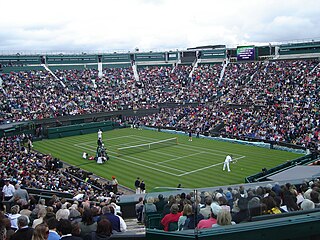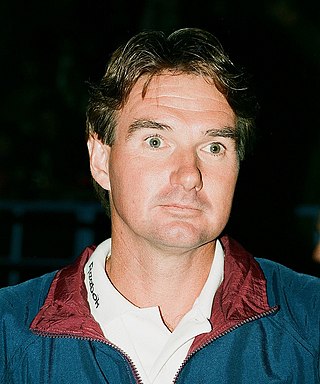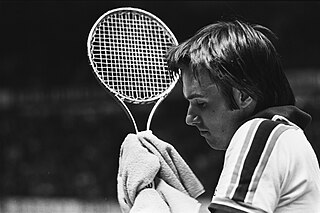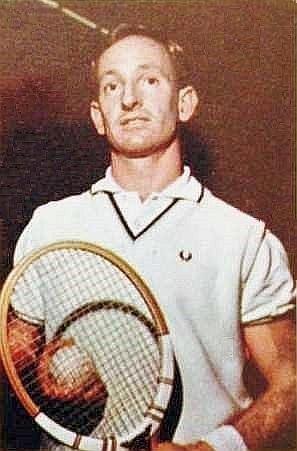
Kenneth Robert Rosewall is an Australian former world top-ranking professional tennis player. Rosewall won 147 singles titles, including a record 15 Pro Majors and 8 Grand Slam titles for a total 23 titles at pro and amateur majors ranks him second all time to Novak Djokovic on 24. He also won 15 Pro Majors in doubles and 9 Grand Slam doubles titles. Rosewall achieved a Pro Slam in singles in 1963 by winning the three Pro Majors in one year and he completed the Career Grand Slam in doubles.
The Association of Tennis Professionals (ATP) is the governing body of the men's professional tennis circuits – the ATP Tour, the ATP Challenger Tour and the ATP Champions Tour. It was formed in September 1972 by Donald Dell, Jack Kramer, and Cliff Drysdale to protect the interests of professional tennis players, and Drysdale became the first president. Since 1990 the association has organized the ATP Tour, the worldwide tennis tour for men and linked the title of the tour with the organization's name. It is the governing body of men's professional tennis. In 1990 the organization was called the ATP Tour, which was renamed in 2001 as just ATP and the tour being called ATP Tour. In 2009 the name of the tour was changed again and was known as the ATP World Tour, but changed again to the ATP Tour by 2019. It is an evolution of the tour competitions previously known as Grand Prix tennis tournaments and World Championship Tennis (WCT). The ATP's global headquarters are in London. ATP Americas is based in Ponte Vedra Beach, Florida; ATP Europe is headquartered in Monaco; and ATP International, which covers Africa, Asia and Australasia, is based in Sydney, Australia.
World Championship Tennis (WCT) was one the principal organizing bodies of men's professional tennis headquartered at the WCT Lakeway World of Tennis facility, Austin, Texas, United States from 1968 to 1989. It administered the WCT Circuit a world wide tour of associated tennis tournaments that was a rival tour to the ITF Grand Prix Circuit both of which were replaced by the Association of Tennis Professionals ATP Tour in 1990.
This article is concerned with the major tennis achievements of tennis male players of all tennis history.

The racket sport traditionally named lawn tennis, invented in Edgbaston, Warwickshire, England, now commonly known simply as tennis, is the direct descendant of what is now denoted real tennis or royal tennis, which continues to be played today as a separate sport with more complex rules.
The U.S. Professional Indoor Championships, also known as U.S. Pro Indoor, was a professional tennis tournament founded in 1962 as the Philadelphia Invitational Indoor Tennis Championships. The tournament was held in Philadelphia, United States from 1962 to 1998. It played on indoor carpet courts, and indoor hard courts. It was an ILTF sanctioned event from 1962 to 1967 and again in 1970, the World Championship Tennis (WCT) circuit in 1968, 1969 and from 1971 to 1977 and the Grand Prix Tour from 1978 to 1989 before being held on the ATP Tour. It was held annually first at the Spectrum, and then at the CoreStates Center. It was originally named the Philadelphia Indoor Open Tournament prior to the open era.

The Virginia Slims World Championship Series or WTA World Championship Series was the women's top tier tennis tour administered by the Women's Tennis Association that was first founded in 1970 as the Virginia Slims Series of events that were then part of ILTF World Circuit. It eventually became the basis for the later WTA Tour. The players, dubbed the Original 9, rebelled against the United States Lawn Tennis Association (USLTA) because of the wide inequality between the amount of prize money paid to male tennis players and to female tennis players. In 1971 it was rebranded as the Virginia Slims Circuit until 1978 and was a rival tour to the ILTF Women's International Grand Prix until 1976. In 1979 it was branded as the Avon Championship Circuit until 1981. In 1982 it was merged with the Toyota International Series as a single women's tennis tour and rebranded under it's last title name until 1989. In 1990 it was succeeded by the WTA World Tour.

This is a list of the main career statistics of Australian former tennis player Rod Laver whose playing career ran from 1956 until 1977. He played as an amateur from 1956 until the end of 1962 when he joined Jack Kramer's professional circuit. As a professional he was banned from playing the Grand Slam tournaments as well as other tournaments organized by the national associations of the International Lawn Tennis Federation (ILTF). In 1968, with the advent of the Open Era, the distinction between amateurs and professionals disappeared and Laver was again able to compete in most Grand Slam events until the end of his career in 1977. During his career he won eleven Grand Slam tournaments, eight Pro Slam tournaments and five Davis Cup titles.

The 1982 Volvo Grand Prix was a professional tennis circuit held that year. It incorporated the four grand slam tournaments, the Grand Prix tournaments. The circuit was administered by the Men's International Professional Tennis Council (MIPTC). On 30 April 1981 World Championship Tennis (WCT) announced its withdrawal from the Grand Prix circuit, which it had been incorporated into since 1978, and the re-establishment of its own tour calendar for the 1982 season. To counter the threat of player leaving the Grand Prix tour for the WCT the MIPTC introduced a mandatory commitment to play at least 10 Grand Prix Super Series tournaments.

The 1981 Volvo Grand Prix was the only men's professional tennis circuit held that year. It consisted of the four Grand Slam tournaments and the Grand Prix tournaments. The World Championship Tennis (WCT) Tour was incorporated into the Grand Prix circuit. The WCT tour consisted of eight regular tournaments, a season's final, three tournaments categorized as special events and a doubles championship. In total 89 tournaments were held divided over 29 countries. The circuit was administered by the Men's International Professional Tennis Council (MIPTC).

The 1980 Volvo Grand Prix was a men's professional tennis circuit held that year. It incorporated the four grand slam tournaments, the Grand Prix tournaments. The Grand Prix circuit is a precursor to the ATP Tour.

The 1979 Colgate-Palmolive Grand Prix was a professional tennis circuit held that year. It consisted of four Grand Slam tournaments, the Grand Prix tournaments and the Nations Cup, a team event.

The 1978 Colgate-Palmolive Grand Prix was a professional tennis circuit held that year. It consisted of four Grand Slam tournaments, the Grand Prix tournaments and the Nations Cup, a team event. In addition eight World Championship Tennis (WCT) tournaments, a separate professional tennis circuit held from 1971 through 1977, were incorporated into the Grand Prix circuit. The 28 tournaments with prize money of $175,000 or more formed the Super Series category. Jimmy Connors won 10 of the 84 tournaments which secured him the first place in the Grand Prix points ranking. However he did not play enough tournaments (13) to qualify for largest share ($300,000) of the bonus pool, which instead went to third–ranked Eddie Dibbs.

The 1977 Colgate-Palmolive Grand Prix was a professional tennis circuit administered by the International Lawn Tennis Federation which served as a forerunner to the current Association of Tennis Professionals (ATP) World Tour and the Women's Tennis Association (WTA) Tour. The circuit consisted of the four modern Grand Slam tournaments and open tournaments recognised by the ILTF. The Colgate-Palmolive Masters is included in this calendar but did not count towards the Grand Prix ranking. Colgate-Palmolive was the new tour sponsor, taking over from Commercial Union. Guillermo Vilas won the Grand Prix circuit, having accumulated the most points (2,047), and received the largest share from the bonus pool ($300,000). The top eight points ranked singles players as well as the top four doubles teams qualified for the season-ending Masters tournament

The 1974 Commercial Union Assurance Grand Prix was a professional tennis circuit administered by the International Lawn Tennis Federation (ILTF) which served as a forerunner to the current Association of Tennis Professionals (ATP) World Tour and the Women's Tennis Association (WTA) Tour. The circuit consisted of the four modern Grand Slam tournaments and open tournaments recognised by the ILTF. The season-ending Commercial Union Assurance Masters and Davis Cup Final are included in this calendar but did not count towards the Grand Prix ranking.

The 1972 Commercial Union Assurance Grand Prix was a professional tennis circuit held that year and organized by the International Lawn Tennis Federation (ILTF). It consisted of 33 Grand Prix tournaments in different categories including three of the four Grand Slam tournaments and was followed by a season-ending Masters tournament. The circuit ran from February through November.

The 1970 Pepsi-Cola ILTF Grand Prix was a tennis circuit administered by the International Lawn Tennis Federation (ILTF) which served as a forerunner to the current Association of Tennis Professionals (ATP) World Tour and the Women's Tennis Association (WTA) Tour. It was the inaugural edition of the Grand Prix circuit and consisted of men's tournaments recognised by the ILTF. The creation of the Grand Prix circuit, on an experimental basis during its first year, was announced in April 1970 by the president of the ILTF, Ben Barnett. It was the brainchild of Jack Kramer, former tennis promoter and winner of the Wimbledon and US championships, and was aimed at countering the influence of commercial promoters, particularly Lamar Hunt and his World Championship Tennis circuit and George MacCall's National Tennis League.

The 1972 ILTF Women's Tennis Circuit was the 58th season since the founding of the International Lawn Tennis Association and was the final season to be solely administered by the ILTF.
The WCT Circuit was a tour for professional male tennis players that commenced in 1968 it lasted until 1989 when it and ITF Grand Prix Circuit were both replaced by the new ATP Tour in 1990. It was administered by World Championship Tennis. A number of tennis tournaments around the world were affiliated with the WCT and players were ranked in special WCT rankings according to their results in those tournaments.
The Toyota International Series was a professional women's tennis circuit administered by the Women's Tennis Association that was founded in 1977 as the Colgate International Series it consisted of tournaments absorbed from the ILTF Women's International Grand Prix and included all those worldwide events that were not part of the Virginia Slims Circuit who's tournaments were mainly in the United States. In 1979 it was renamed as the Colgate Series. In 1981 the Toyota Motor Corporation took over sponsorship of the circuit from the Colgate-Palmolive Company where it resumed under its last title name until 1982.












